What Does It Mean When a Feral Cat Rolls on Its Back? Decoding Cat Signals
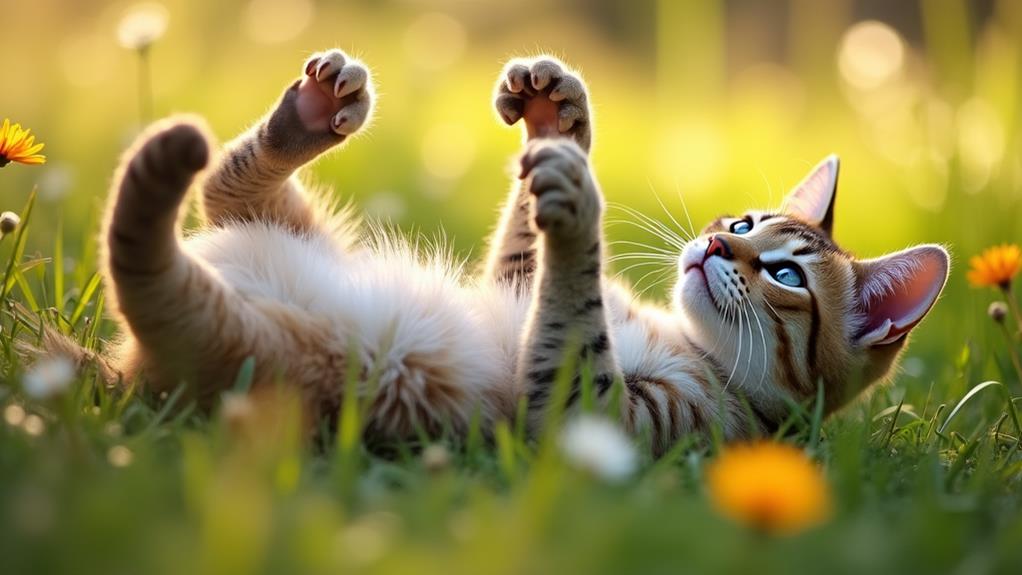
When a feral cat rolls on its back, it's showing trust and comfort. This behavior can mean it feels safe enough to expose its vulnerable belly, marking you or the area with scent glands. It could be seeking attention, signaling playfulness, or even communicating mating readiness. Unlike dogs, this isn't submission but a bold display of confidence. Pay attention to the context and body language, like ear position and tail movement, to avoid misunderstandings. Understanding these cues enriches your interactions and helps you appreciate the complex language of feral cats. Uncover more about what these fascinating behaviors signify.
Safety and Trust
When feral cats roll on their backs, they're signaling a significant level of safety and trust. This vulnerable position exposes their belly, showing they feel secure in their environment. It's a remarkable cat behavior, especially since feral cats are naturally cautious. When you see this, it indicates the cat is in a relaxed state, often referred to as "kitty zen mode." At this moment, they're comfortable and at ease, open to positive reinforcement.
However, you should tread carefully with belly rubs. Not all cats enjoy this level of interaction. Some may appreciate gentle strokes, while others might feel overstimulated. It's essential to read the cat's body language to avoid negative reactions. A cat lying on its back can be an opportunity for bonding, but only if approached with caution and respect for their boundaries.
When a feral cat trusts you enough to roll over, it's a clear sign of their growing comfort with human interaction. This behavior reflects a positive affirmation of their comfort level. So, when you encounter a feral cat displaying this behavior, take it as a compliment to your presence and understanding of their needs.
Attention-Seeking Behavior
Feral cats often display attention-seeking behavior by rolling on their backs, a clear sign they're comfortable and relaxed in familiar surroundings. This action suggests that the feral cat feels safe and secure enough to expose its vulnerable belly, a gesture that's not typically seen unless they trust their environment. When a feral cat rolls on its back near humans, it might be inviting interaction, signaling a desire to engage and receive attention.
You might notice this behavior is more common around feeding times or when there's human activity nearby. Cats are observant creatures and can quickly learn routines that may result in positive interactions. While you might be tempted to respond with a belly rub, keep in mind that not all cats enjoy this. Each cat has its own boundaries, and respecting these is essential to maintaining a harmonious relationship. Overstepping these limits can lead to overstimulation, which could result in defensive behavior.
In essence, when a feral cat rolls on its back, it's trying to communicate its comfort and openness to interaction. By acknowledging this behavior, you can better understand and respect the boundaries of your feline friend.
Scent Marking
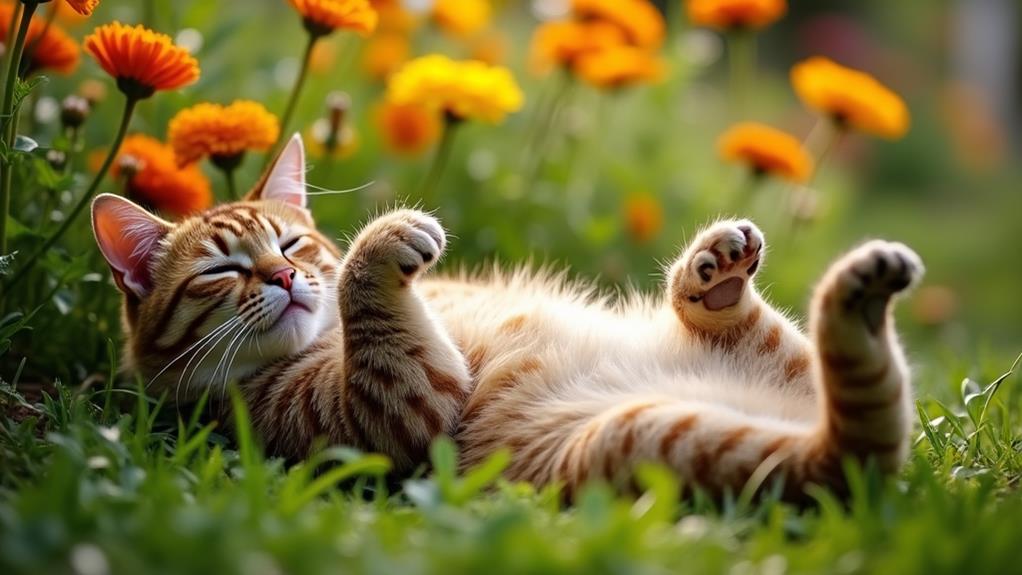
Rolling on their backs, feral cats spread their scent to mark territory and communicate their presence to others. This scent marking is essential for them, as it helps establish their identity and status within a specific area. When a feral cat rolls, they activate scent glands located on their cheeks, paws, and flanks. This behavior isn't just random; it's an intentional act of communication with other cats.
By leaving their scent, feral cats send a clear message: they've claimed the space and are setting boundaries. This strong scent marking can deter potential rivals, reducing the chances of conflict. It's an efficient way for feral cats to maintain their territory without constant confrontations.
Furthermore, when they roll, they distribute pheromones from their skin. These pheromones carry crucial information about their reproductive status and general health. Other feral cats can "read" this information, gaining insights into the roller's identity and condition. Rolling is part of a wider social interaction strategy, complementing other marking methods to create a thorough scent trail. This trail weaves a story of the cat's presence, identity, and status in their environment.
Mating Signals
A feral female cat might roll on her back to signal that she's in heat, attracting male cats through the pheromones she releases. This behavior is a strong mating signal that occurs due to hormonal changes during the mating season. These changes heighten her instincts and competitiveness, making her actions vital in the search for potential mates. Male cats are significantly sensitive to the pheromones emitted by the female's rolling, allowing them to detect her readiness to mate even from a distance.
The rolling not only serves to attract potential mates but also helps the female cat remove any lingering male scents after mating. This prepares her for further mating opportunities, ensuring she enhances her chances of reproduction. For those managing feral cat populations, understanding these signals is fundamental. It highlights the periods when these cats are most active in mating, indicating prime times for spaying or neutering efforts. By focusing on these times, you can effectively control the population and prevent unwanted litters. Recognizing and interpreting these mating signals can lead to more precise interventions in feral cat communities, promoting healthier and more sustainable environments.
Catnip Influence
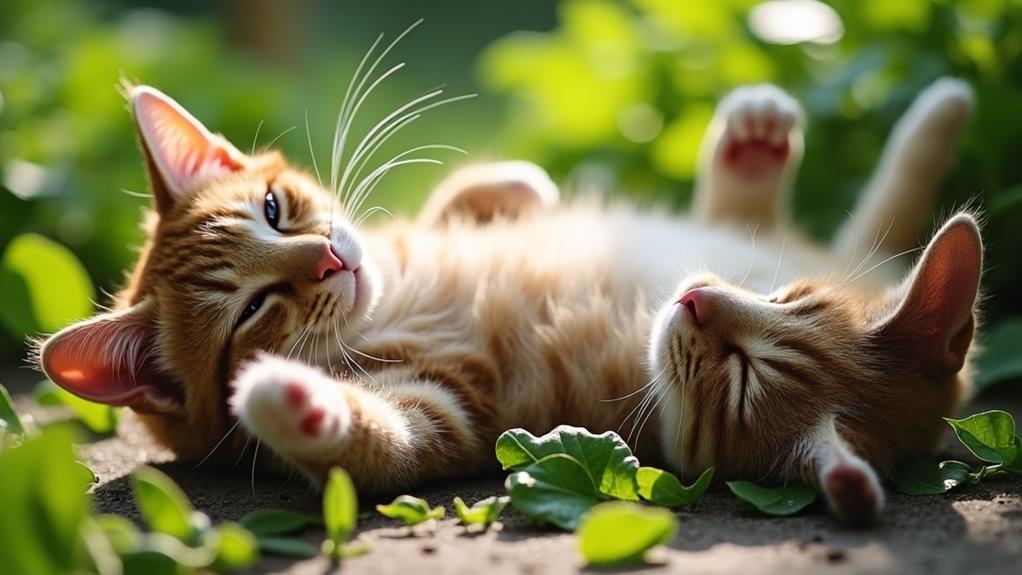
In conjunction with hormonal shifts, the influence of catnip on feline behavior is both fascinating and significant. Catnip contains nepetalactone, a compound that triggers euphoric behaviors in cats by interacting with their brain's receptors. When a cat encounters catnip, it might start rolling on its back, a clear sign of heightened excitement and arousal. This playful behavior reflects the cat's temporary state of euphoria, which usually lasts between 5 to 15 minutes. During this time, the cat is fully engaged in its response to catnip, showcasing a mix of joy and contentment.
Interestingly, not all cats react to catnip. Sensitivity to this plant is hereditary, with about 50-75% of cats showing any reaction at all. For those that do, rolling serves another purpose beyond mere enjoyment. As cats roll in catnip, they also mark their territory using scent glands located on their cheeks and paws. This dual action of experiencing euphoria and claiming territory highlights the complex nature of cat behavior. After the effects wear off, cats often lose interest, becoming temporarily desensitized to catnip's allure, only to return to it with renewed enthusiasm later on.
Not Submissive
For feral cats, rolling on their backs isn't about submission but rather a display of comfort and trust in their surroundings. It's easy to misinterpret this behavior, especially if you're more familiar with dogs, which often roll over to show submission. When a cat rolls, it doesn't mean they're asking for a belly rub or showing deference. Instead, this is a bold statement that they feel safe in their environment.
Cats are independent creatures, and their body language can be complex. In the wild, feral cats need to be constantly aware of their surroundings, so when they roll over, they're indicating a level of trust in the safety of their immediate area. For cat owners observing this behavior, it's vital to understand that the cat is not submissive. It's simply showcasing its relaxed state and confidence.
This behavior also communicates to other cats nearby, signaling presence and state of mind. By recognizing this, you can better interpret your feral friend's actions. Avoid assuming they're seeking affection in the form of a belly rub, as this could lead to defensive reactions if misjudged. Understanding Cats Body Language helps in building a positive relationship.
Body Language Insights
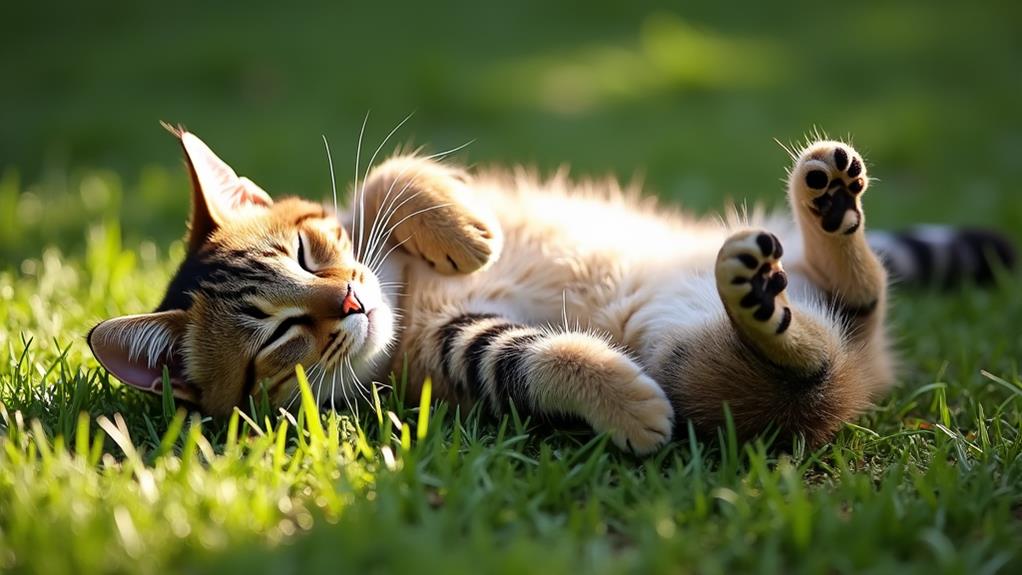
Understanding a feral cat's body language can offer valuable insights into its emotional state and intentions. When a cat rolls onto their back, it might seem like an open invitation for a belly rub, but that's not always the case. This vulnerable position can indicate trust, suggesting the cat feels safe in its environment. However, many cats prefer you leave their bellies untouched, even if they seem inviting.
When you see a feral cat rolling on its back, pay attention to other body signs. For instance, if the cat's tail is relaxed and its ears are forward, it might be feeling playful or seeking interaction. This behavior could also mean the cat is marking its territory by spreading scent from glands on its cheeks and flanks.
It's crucial to observe the context in which this behavior occurs. If the cat is in a familiar setting or near humans it trusts, the rolling might be a sign of relaxed contentment. Always approach with caution and respect the cat's boundaries, as understanding its body language is key to interpreting its feelings and intentions correctly.
Cultural Differences
Recognizing a feral cat's body language is just one piece of the puzzle; how cats are perceived can differ greatly depending on cultural perspectives. In the U.K., for instance, cats often have the freedom to roam outdoors, which influences how people interpret their behavior. A cat that rolls on its back in a public space might be seen as content and trusting, reflecting a community-based approach to their care. In contrast, American cat owners might prioritize keeping cats indoors, interpreting a roll as a sign of trust within the confines of a secure environment, away from predators or traffic.
In some cultures, outdoor cats are an accepted part of community life, leading to a variety of attitudes toward feral cat populations. For example, some European countries welcome feral cats, with locals often offering care and viewing them as community members. This cultural acceptance can mean that signals such as rolling are seen as normal behavior rather than a nuisance. Conversely, in regions where feral cats are less welcome, rolling might be misinterpreted due to a lack of understanding. Cultural beliefs about animal welfare also shape practices like TNR, which humanely manage feral populations, reflecting varying levels of awareness and education.
Understanding Cat Behavior
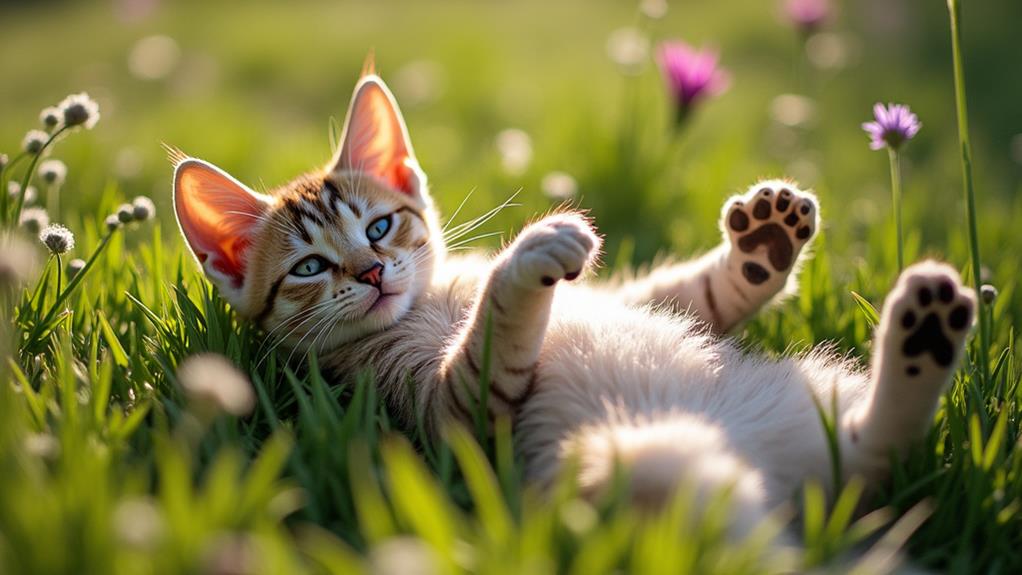
When you observe a feral cat rolling on its back, you're witnessing a complex form of communication. This behavior can be puzzling, but it's a mix of instinctual actions and emotional cues. When a cat feels relaxed around you or its environment, rolling can be a clear sign that the cat trusts its surroundings. However, there's more than one message being conveyed.
Here's what a feral cat might be trying to tell you when it rolls on its back:
- Comfort and Security: The cat feels safe and unthreatened.
- Invitation for Interaction: It might be open to social engagement with other cats or even humans.
- Scent Marking: By rolling, the cat is spreading its scent, marking its territory.
- Skin Irritation: If it's scratching persistently, it may have skin irritations or fleas.
- Playful Behavior: Sometimes, it's simply in a playful mood.
Understanding these signals is essential. Rolling can indicate a state of vulnerability, but it also presents an opportunity for bonding. Knowing what the cat is trying to tell you helps foster a better relationship and guarantees you respect its boundaries.




